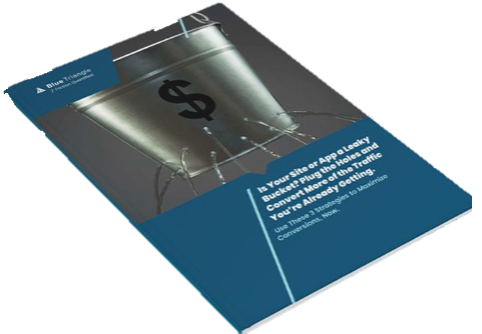The success of any site or mobile app hinges on understanding the Five Friction Forces to drive conversions and grow customer loyalty.
In an episode of The Frictionless Experience, our podcast for Friction Fighters slaying friction in their customers' digital experiences, we explored one of those forces: Usability and Functionality.
On the go? Listen to the episode below!
What is Usability and Functionality?
Usability and Functionality refers to how easily a consumer can navigate and complete a transaction on your site. If you cannot deliver users what they're looking for, then 79% will immediately go to another site.
Don't let poor Usability and Functionality be a reason why you disappoint a new or loyal customer.
On the podcast episode, co-hosts Chuck Moxley and Nick Paladino are joined by eCommerce and omnichannel retail pro Mike Shady.
Mike's executive experience at home improvement giants Lowe's and Home Depot is unmatched. He grew a prominent online business by billions of dollars, adding thousands of functionality improvements, and establishing the company as a leader in home improvement.
You don't want to miss what he says about mastering Usability and Functionality to minimize customer friction and maximize loyalty.
5 Takeaways: Usability and Functionality
1. Recognize how Usability and Functionality jive with the Five Friction Forces.
While all Five Friction Forces are important, such as aesthetics (the visual appeal of your site) or speed, they must go hand in hand with robust, user-friendly functionality.
A beautifully designed and fast site or app is only useful if it functions smoothly. If it's not optimized for customers' needs, then they'll abandon your site for one that provides a better experience.
Friction caused by Usability and Functionality could include:
- Confusing navigation causing users to feel lost and frustrated.
- No personalization, like product recommendations or content suggestions based on the user's history.
Tailoring the digital experience based on user needs and expectations can significantly reduce friction.
For example, Mike shared how he personalized experiences for home improvement professionals versus do-it-yourselfers. It's imperative to recognize the distinct needs of different user groups to offer the best possible experience for them.
2. Measure the impact of Usability and Functionality.
"If you can't measure it you can't improve it," said Peter Drucker, one of the most influential thinkers on management.
When it comes to Usability and Functionality, you can achieve this by collecting and analyzing real user data, such as customer feedback, user testing, and A/B test results, to uncover insights before, during, and after releasing new site functionality.
Here are some metrics to look out for:
- Conversion rates
- Revenue opportunity
- Customer journey analysis
These are all indicators that serve as a window into the user experience. They tell us how well we meet our customers' needs and expectations.
By isolating your site's Usability and Functionality components, you can then measure its revenue and customer experience impact by looking at your unique conversion rate curves. This will offer concrete data on how Usability and Functionality affect your bottom line and customer experience.
Through this customer-first, data-driven approach to quantifying and resolving friction, you can prioritize improvement areas that will drive more conversions and build stronger customer loyalty.
We call this Continuous Experience Optimization.
3. Quickly identify and resolve costly friction.
It's proven that when customers encounter friction, it can cost your brand lost revenue. So, teams must be prepared to act quickly to minimize customer disruption and its financial impact.
But it's also about more than just the immediate revenue impact. It's causing you to lose precious trust and loyalty from your customers.
A well-coordinated response and timely resolution to nip costly friction in the bud will help you deliver a smooth, friction-free experience for your customers while reinforcing your company's ability to grow customer trust and loyalty.
4. Have a customer-first mentality to understand their needs and friction points.
One common mistake many companies make is assuming they know what's best for their customers without truly understanding them.
For example, when visitors land on your site, do they know what to do or where to go? Releasing new functionality that prevents them from taking the next step could create an experience that fails to resonate with customers and jeopardizes your conversion rate goals.
Measuring conversion rates, revenue opportunities, and customer journey analytics will provide insights into the customer experience.
But another great way to achieve this is by becoming your own customer. Navigating and shopping on your site will give you a first-hand perspective on the customer experience.
5. Collaboration clears the path to creating frictionless experiences.
Successfully minimizing friction and maximizing customer loyalty requires fostering proactive collaboration across your organization. You need to have the right people at the table from cross-functional teams, including:
- Digital
- Product
- Marketing
- Engineering
Solving Usability and Functionality friction and optimizing the customer experience comes from having the right people at the table – people from digital, product, marketing, and engineering teams.
Combining the expertise from various departments can bring diverse perspectives and solutions to the forefront to work towards removing friction and optimizing the customer experience.
Site Usability and Functionality Matters
The Five Friction Forces – Marketing, Seasonality, Aesthetics, Speed, and, you guessed it, Usability and Functionality – constantly fluctuate and impact the customer experience in different ways.
That's something you and I know. But here's the thing: customers often don't distinguish between them. A bad experience is simply a bad experience.
That's why teams must master all Five Friction Forces to deliver an all-around satisfying customer experience.
It's not just about driving demand and having a beautifully designed, fast site; it's also about ensuring it functions seamlessly and caters to diverse user needs.
Here is a summary of what you need to know:
- Tailoring experiences based on different types of customers and deploying customer-first, data-driven Usability and Functionality optimizations will reduce friction in the customer journey.
- Analyzing your conversion rates and conversion rate curves, revenue opportunities, and customer journey analytics will unveil user experience insights and help you improve Usability and Functionality.
- Addressing Usability and Functionality issues quickly and across the organization can minimize the impact of avoidable friction and create exceptional experiences that enhance customer trust and loyalty.
About The Frictionless Experience
Are you a Friction Fighter on the frontlines of slaying friction in your customers' digital experiences? Then The Frictionless Experience is a must-listen!
Join us at TheFrictionlessExperience.com for engaging conversations with visionary leaders and industry experts who have dedicated their careers to pushing the boundaries of digital excellence. We'll share insider strategies, stories, and advice that will revolutionize your users' experiences and drive unparalleled customer loyalty and revenue through your site and mobile app.
Listen to The Frictionless Experience wherever you get your favorite podcasts, including:
Subscribe to never miss an episode, leave a review, and let us know any topics you'd like us to cover!

During the holiday rush, every shopper matters
Optimize the customer journey before the eCommerce event of the year.

.jpg)

